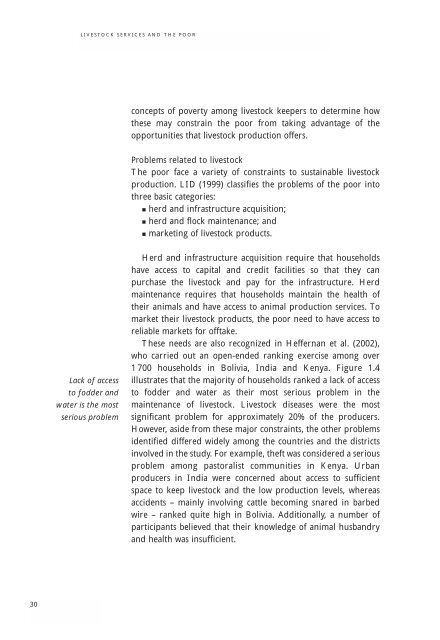Livestock Services and the Poor: A global initiative - IFAD
Livestock Services and the Poor: A global initiative - IFAD
Livestock Services and the Poor: A global initiative - IFAD
Create successful ePaper yourself
Turn your PDF publications into a flip-book with our unique Google optimized e-Paper software.
30<br />
LIVESTOCK SERVICES AND THE POOR<br />
Lack of access<br />
to fodder <strong>and</strong><br />
water is <strong>the</strong> most<br />
serious problem<br />
concepts of poverty among livestock keepers to determine how<br />
<strong>the</strong>se may constrain <strong>the</strong> poor from taking advantage of <strong>the</strong><br />
opportunities that livestock production offers.<br />
Problems related to livestock<br />
The poor face a variety of constraints to sustainable livestock<br />
production. LID (1999) classifies <strong>the</strong> problems of <strong>the</strong> poor into<br />
three basic categories:<br />
herd <strong>and</strong> infrastructure acquisition;<br />
herd <strong>and</strong> flock maintenance; <strong>and</strong><br />
marketing of livestock products.<br />
Herd <strong>and</strong> infrastructure acquisition require that households<br />
have access to capital <strong>and</strong> credit facilities so that <strong>the</strong>y can<br />
purchase <strong>the</strong> livestock <strong>and</strong> pay for <strong>the</strong> infrastructure. Herd<br />
maintenance requires that households maintain <strong>the</strong> health of<br />
<strong>the</strong>ir animals <strong>and</strong> have access to animal production services. To<br />
market <strong>the</strong>ir livestock products, <strong>the</strong> poor need to have access to<br />
reliable markets for offtake.<br />
These needs are also recognized in Heffernan et al. (2002),<br />
who carried out an open-ended ranking exercise among over<br />
1 700 households in Bolivia, India <strong>and</strong> Kenya. Figure 1.4<br />
illustrates that <strong>the</strong> majority of households ranked a lack of access<br />
to fodder <strong>and</strong> water as <strong>the</strong>ir most serious problem in <strong>the</strong><br />
maintenance of livestock. <strong>Livestock</strong> diseases were <strong>the</strong> most<br />
significant problem for approximately 20% of <strong>the</strong> producers.<br />
However, aside from <strong>the</strong>se major constraints, <strong>the</strong> o<strong>the</strong>r problems<br />
identified differed widely among <strong>the</strong> countries <strong>and</strong> <strong>the</strong> districts<br />
involved in <strong>the</strong> study. For example, <strong>the</strong>ft was considered a serious<br />
problem among pastoralist communities in Kenya. Urban<br />
producers in India were concerned about access to sufficient<br />
space to keep livestock <strong>and</strong> <strong>the</strong> low production levels, whereas<br />
accidents – mainly involving cattle becoming snared in barbed<br />
wire – ranked quite high in Bolivia. Additionally, a number of<br />
participants believed that <strong>the</strong>ir knowledge of animal husb<strong>and</strong>ry<br />
<strong>and</strong> health was insufficient.

















